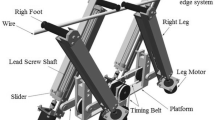Abstract
Intelligent overhead distribution line work must be realized to solve the problem of line operation and maintenance. Routine manual detection has serious hidden safety issues in the distribution network of overhead transmission line maintenance and maintenance work. As such, the design of a climbing rod robot has widely adopted a fully round structure, to ensure reliability and efficiency stability. However, at the moment, pole-climbing robots face several issues, such as low efficiency, unstable obstacle crossing ability, complex control system, and low degree of intelligence, all of which have a significant impact on the design and actual use of various types of pole-climbing robots. In order to improve the obstacle climbing ability of the climbing robot and solve the problem of unmanned climbing operation, from the perspective of climbing efficiency and obstacles, this research proposes a semi-closed double-wheel climbing robot with an obstacle climbing function based on the basic structure of a wheel climbing robot. Moreover, the study discusses the overall design, motion simulation, and force analysis and describes the analysis of the climbing robot. The results of this research reveal that combining the stability and mobility of the wheeled robot with the obstacle passing ability of the triangle wheel, the obstacle passing height is increased to 0.65 times the wheel diameter by switching the obstacle passing mode; the double-layer triangular wheel obstacle crossing mechanism is adopted to provide enough climbing rod thrust and clamping stability, which increases the height of the obstacle crossing by 1.5 times.










Similar content being viewed by others
References
Alkalla MG et al (2017) Tele-operated propeller-type climbing robot for inspection of petrochemical vessels. Indust Robot Int J Robot Res Appl 44(2):166–177
Seo B et al (2013) FlipBot: a new field robotic platform for fast stair climbing. Int J Precis Eng Manuf 14(11):1909–1914
Alexander R et al (2003) A mobile climbing robot for high-precision manufacture and inspection of aero-structures. Climbing and Walking Robots: And Their Supporting Technologies, 777–784.
Aracil R, Saltaren RJ, Reinoso O (2006) A climbing parallel robot. IEEE Robot Autom Mag 13(1):16–22
Chen WN et al (2018) Representation of truss-style structures for autonomous climbing of biped pole-climbing robots. Robot Auton Syst 101:126–137
Du QL et al (2020) The obstacle-surmounting analysis of a pole-climbing robot. Int J Adv Robot Syst 17(6):1729881420979146
Noohi E et al (2010) Wheel-based climbing robot: modeling and control. Adv Robot 24(8–9):1313–1343
Baghani A, Ahmadabadi M.N, and Harati A (2005) Kinematics modeling of a wheel-based pole climbing robot (UT-PCR). 2005 IEEE International Conference on Robotics and Automation, 1–4: 2099–2104
Mahdavi S, Noohi E, and Ahmadabadi MN (2006) Path planning of the nonholonomic pole climbing robot UT-PCR. 2006 IEEE International Conference on Robotics and Biomimetics, 1–3: 1517.
Chou YC et al (2012) Bio-inspired step-climbing in a hexapod robot. Bioinspir Biomim 7(3):036008
Aoyagi R, Homma Y, Ito K (2017) Six-legged robot capable of climbing various columnar objects. Int Conf Adv Mechat Syst 2017:24–29
Tavakoli M, Marques L, and Bonsignorio F (2010) Biomimetic Inspiration in Climbing Robots. Emerging Trends in Mobile Robotics,p 221–228.
Tavakoli M et al (2016) The hybrid OmniClimber robot: wheel based climbing, arm based plane transition, and switchable magnet adhesion. Mechatronics 36:136–146
Brockmann W (2006) Concept for energy-autarkic, autonomous climbing robots. Climbing and Walking Robots, p. 107–114.
Sun GL et al (2017) A climbing robot for inspection of lamppost in the airport: design and preliminary experiments. In: 2017 IEEE international conference on robotics and biomimetics (IEEE Robio 2017), pp 436–441
Pavone M et al (2006) Climbing obstacle in bio-robots via CNN and adaptive attitude control. Int J Circuit Theory Appl 34(1):109–125
dos Santos CHF et al (2021) Geometrical motion planning for cable-climbing robots applied to distribution power lines inspection. Int J Syst Sci 52(8):1646–1663
Aniroh Y et al (2015) Dynamics and Control of a Suction-Type Wall-Climbing Robot. Ifac Papersonline 48(1):902
Chu B et al (2010) A Survey of Climbing Robots: Locomotion and Adhesion. Int J Precis Eng Manuf 11(4):633–647
FischerW, and Siegwart R (2010) Wheeled pole-climbing-robot with high payload capability, using a clamping mechanism which is inspired by the rope-clamps in human climbing. Emerging Trends In Mobile Robotics, p. 399–406.
Bian SY et al (2021) A Four-legged wall-climbing robot with spines and miniature setae array inspired by longicorn and gecko. J Bionic Eng 18(2):292–305
Guo TT et al (2022) Development of a new hull adsorptive underwater climbing robot using the Bernoulli negative pressure effect. Ocean Eng 243:110306
Zhou ZH, and Zhu XQ (2020), Design and simulation of special hexapod robot with vertical climbing ability. Proceedings of 2020 IEEE 5th Information technology and mechatronics engineering conference (Itoec 2020), p. 746–749.
Acknowledgements
This work is supported by the Science and Technology Project of Anhui Electric Research Institute of State Grid Corporation of China (Grant No. 52120520005B) and the National Natural Science Foundation of China (Grant No. 51975174 and No. 51975005).
Author information
Authors and Affiliations
Contributions
WW was contributed to conceptualization, methodology. LZ was contributed to data curation, writing—original draft preparation. Chen Kai was contributed to visualization, investigation. FY was contributed to supervision. WS was contributed to writing, reviewing and editing.
Corresponding author
Ethics declarations
Conflict of interest
NO potential conflicts of interest was reported by the authors.
Ethical approval
Ethical approval is not required for this paper.
Additional information
Technical Editor: Rogério Sales Gonçalves.
Publisher's Note
Springer Nature remains neutral with regard to jurisdictional claims in published maps and institutional affiliations.
Rights and permissions
Springer Nature or its licensor (e.g. a society or other partner) holds exclusive rights to this article under a publishing agreement with the author(s) or other rightsholder(s); author self-archiving of the accepted manuscript version of this article is solely governed by the terms of such publishing agreement and applicable law.
About this article
Cite this article
Lu, Z.J., Wu, S.L., Feng, Y. et al. Climbing robot based on triangle wheels obstacle crossing design: modeling simulation and motion analysis. J Braz. Soc. Mech. Sci. Eng. 45, 539 (2023). https://doi.org/10.1007/s40430-023-04468-4
Received:
Accepted:
Published:
DOI: https://doi.org/10.1007/s40430-023-04468-4




